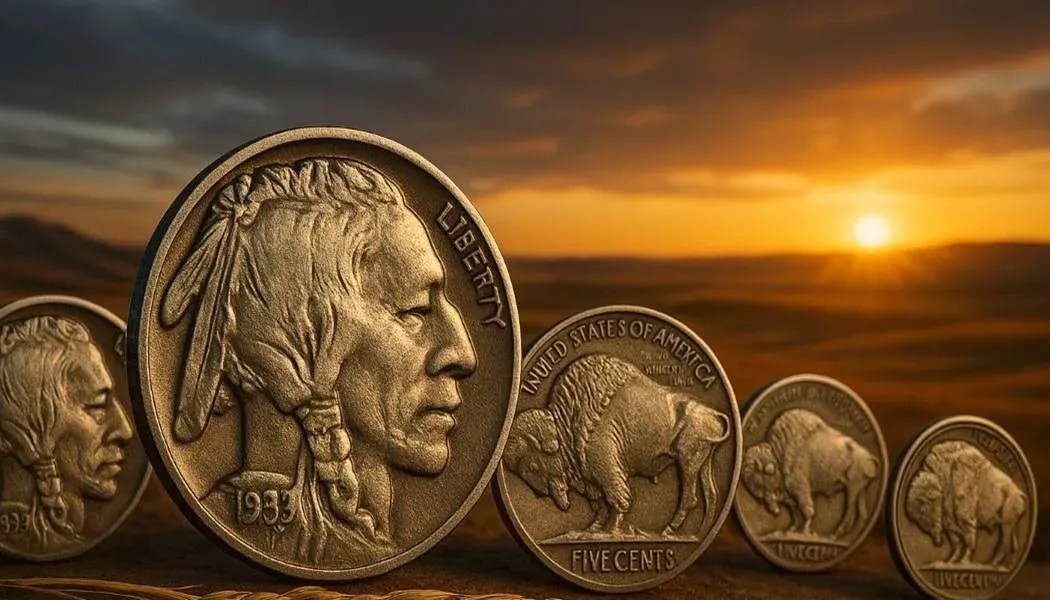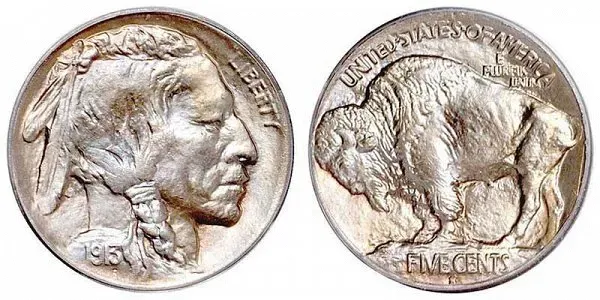Buffalo Nickels (1913–1938): A True Icon of American Coinage

A Distinctive Chapter in U.S. Numismatic History
Among America’s most celebrated coins, the Buffalo Nickel—also known as the Indian Head Nickel—was minted from 1913 to 1938 and remains one of the most instantly recognizable U.S. coin designs. Beloved for its artistry and symbolic imagery, the Buffalo Nickel has earned a permanent place in numismatic history. Collectors are drawn to the series not only for its distinctive appearance but also for the cultural and historical narratives it represents.
Inspiration and the Designer Behind the Nickel
The Buffalo Nickel was introduced as part of President Theodore Roosevelt’s campaign to revitalize U.S. coinage, which sought to replace uninspired designs with more artistic and distinctly American motifs.
The task was given to sculptor James Earle Fraser, a former student of Augustus Saint-Gaudens. Fraser drew inspiration from his own childhood experiences on the American frontier and from his admiration for Native American culture. The result was a design that continues to stand out more than a century later.
The Design: Honoring Native America and the Frontier
🔹 Obverse: A composite portrait of three Native American chiefs—reportedly Iron Tail (Sioux), Two Moons (Cheyenne), and possibly Big Tree (Kiowa). Fraser combined features from multiple individuals to create a dignified and powerful profile, accompanied by the word “LIBERTY” and the year of issue.
🔹 Reverse: A massive American bison, widely believed to be modeled after “Black Diamond,” a bison housed at the Central Park Zoo in New York. The inscriptions include “UNITED STATES OF AMERICA”, “E PLURIBUS UNUM”, and the denomination “FIVE CENTS.”
1913 Buffalo Nickel
The coin’s bold design carried both patriotic and symbolic weight, but it also posed challenges: the date and denomination wore down easily in circulation, creating varieties and errors that today intrigue collectors.
Key Dates and Varieties: The Most Sought-After Buffalo Nickels
While many Buffalo Nickels remain affordable in circulated condition, the series also boasts legendary rarities and key issues that command high premiums:
🔹 1913-S Type 2 Buffalo Nickel
The “Type 2” reverse lowered the denomination onto a raised mound, which wore poorly in circulation. Low mintage San Francisco issues from 1913 are among the toughest early-date coins to find.
🔹 1916 Doubled Die Obverse
One of the most famous error coins in U.S. history. The date and legend show dramatic doubling, making this variety a standout rarity.
🔹 1918/7-D Overdate
A Denver Mint overdate error in which the “7” is visible beneath the “8.” This variety is scarce in all grades and highly coveted.
🔹 1931-S Buffalo Nickel
One of the lowest mintage issues of the series, with just 1.2 million struck. Despite being a later date, its scarcity keeps demand strong.
Perhaps the most famous variety in the series, caused by overpolishing of the die that erased the bison’s front leg. This error coin has become a staple in advanced collections.
Why Collectors Value the Buffalo Nickel Today
The Buffalo Nickel continues to hold a special place in the hearts of numismatists for several reasons:
🔹 Artistry: Fraser’s bold design is regarded as one of the finest in U.S. coinage, capturing both Native American dignity and the frontier spirit.
🔹 Variety of Collecting Approaches: From type sets to full date-and-mint mark collections, the series offers challenges for collectors at every level.
🔹 Historical Resonance: The coin reflects early 20th-century America—its culture, symbolism, and artistic renaissance.
🔹 Rarities and Errors: Key dates and varieties such as the 1918/7-D and 1937-D Three-Legged Buffalo ensure continued intrigue and high auction prices.
Legacy and Enduring Appeal
Although replaced by the Jefferson Nickel in 1938, the Buffalo Nickel’s legacy continues. Its design has been revived on modern U.S. Mint issues, including the 2001 commemorative silver dollar and the American Buffalo gold bullion coin introduced in 2006. These tributes underscore the enduring popularity of Fraser’s work.
For collectors, the Buffalo Nickel offers an engaging journey through artistry, symbolism, and American heritage. Whether acquiring common circulated examples or chasing iconic rarities, this series bridges history and numismatics, making it one of the most celebrated U.S. coin series of the 20th century.
Image source: usacoinbook.com
Another article that may interest you:
Top 25 Most Valuable Buffalo Nickels and Their History
Lincoln Wheat Pennies (1909–1958): Collecting America’s Past
